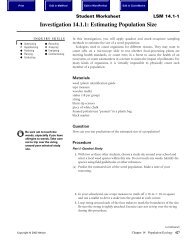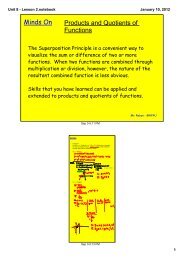Chapter 11.pdf
Chapter 11.pdf
Chapter 11.pdf
- No tags were found...
Create successful ePaper yourself
Turn your PDF publications into a flip-book with our unique Google optimized e-Paper software.
Concave LensesA diverging lens is sometimes called a concave lens because it isthinner in the centre than at the edges. As parallel light rays passthrough a concave lens, they are refracted away from the principal axis.This means the light rays diverge and they will never meet on the otherside of the lens (Figure 11.51). The image formed is always upright andsmaller than the object (Figure 11.52 and Table 11.6).Figure 11.51 A concave lens causes lightrays to diverge.Figure 11.52 A diverging lens forms anupright, smaller image.Table 11.6 Images Formed by Concave LensesDistance of Objectfrom LensType of ImageFormedHow the Image Is UsedRay DiagramAll distancesSmaller,uprightSome types of eyeglassesand telescopes make useof the diverging propertiesof concave lenses. Theselenses are often used incombination withconverging lenses.object ray 1ray 2F imageDrawing a Ray Diagram for a LensA ray diagram is a useful tool for predicting and understanding howimages form as a result of light rays emerging from a lens. The indexof refraction of a lens is greater than the index of refraction of air.This means that when a light ray passes from air into the lens, thelight ray bends, or refracts, away from the lens surface and towardthe normal. When the light passes out of the lens at an angle, the lightrays refract again, this time bending away from the normal. In otherwords, light rays undergo two refractions, the first on entering thelens and the second on leaving the lens (Figure 11.53).(a)(b)Figure 11.53 (a) Concave lens(b) and convex lensRay diagrams model the behaviour of light in mirrors and lenses.451
















